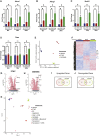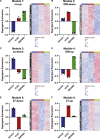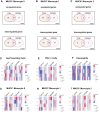The Liver X Receptor Is Selectively Modulated to Differentially Alter Female Mammary Metastasis-associated Myeloid Cells
- PMID: 35569056
- PMCID: PMC9188661
- DOI: 10.1210/endocr/bqac072
The Liver X Receptor Is Selectively Modulated to Differentially Alter Female Mammary Metastasis-associated Myeloid Cells
Abstract
Dysregulation of cholesterol homeostasis is associated with many diseases such as cardiovascular disease and cancer. Liver X receptors (LXRs) are major upstream regulators of cholesterol homeostasis and are activated by endogenous cholesterol metabolites such as 27-hydroxycholesterol (27HC). LXRs and various LXR ligands such as 27HC have been described to influence several extra-hepatic biological systems. However, disparate reports of LXR function have emerged, especially with respect to immunology and cancer biology. This would suggest that, similar to steroid nuclear receptors, the LXRs can be selectively modulated by different ligands. Here, we use RNA-sequencing of macrophages and single-cell RNA-sequencing of immune cells from metastasis-bearing murine lungs to provide evidence that LXR satisfies the 2 principles of selective nuclear receptor modulation: (1) different LXR ligands result in overlapping but distinct gene expression profiles within the same cell type, and (2) the same LXR ligands differentially regulate gene expression in a highly context-specific manner, depending on the cell or tissue type. The concept that the LXRs can be selectively modulated provides the foundation for developing precision pharmacology LXR ligands that are tailored to promote those activities that are desirable (proimmune), but at the same time minimizing harmful side effects (such as elevated triglyceride levels).
Keywords: 27-hydroxycholesterol; SLXRM; SLiMs; breast cancer; liver X receptor; myeloid cell; nuclear receptor; selective LXR modulator.
© The Author(s) 2022. Published by Oxford University Press on behalf of the Endocrine Society. All rights reserved. For permissions, please e-mail: journals.permissions@oup.com.
Conflict of interest statement
The authors declare that they have no conflict of interest and nothing to disclose.
Figures





Similar articles
-
27-Hydroxycholesterol acts on myeloid immune cells to induce T cell dysfunction, promoting breast cancer progression.Cancer Lett. 2020 Nov 28;493:266-283. doi: 10.1016/j.canlet.2020.08.020. Epub 2020 Aug 28. Cancer Lett. 2020. PMID: 32861706 Free PMC article.
-
Constitutive activation of LXR in macrophages regulates metabolic and inflammatory gene expression: identification of ARL7 as a direct target.J Lipid Res. 2011 Mar;52(3):531-9. doi: 10.1194/jlr.M010686. Epub 2010 Dec 27. J Lipid Res. 2011. PMID: 21187453 Free PMC article.
-
Liver × receptor ligands disrupt breast cancer cell proliferation through an E2F-mediated mechanism.Breast Cancer Res. 2013 Jun 20;15(3):R51. doi: 10.1186/bcr3443. Breast Cancer Res. 2013. PMID: 23809258 Free PMC article.
-
Liver X receptors as potential therapeutic targets in atherosclerosis.Clin Invest Med. 2009 Oct 1;32(5):E383-94. doi: 10.25011/cim.v32i5.6927. Clin Invest Med. 2009. PMID: 19796580 Review.
-
The liver X receptor: control of cellular lipid homeostasis and beyond Implications for drug design.Prog Lipid Res. 2010 Oct;49(4):343-52. doi: 10.1016/j.plipres.2010.03.002. Epub 2010 Apr 2. Prog Lipid Res. 2010. PMID: 20363253 Review.
Cited by
-
Endogenous estrogen receptor modulating oxysterols and breast cancer prognosis: Results from the MARIE patient cohort.Br J Cancer. 2023 Aug;129(3):492-502. doi: 10.1038/s41416-023-02315-w. Epub 2023 Jun 24. Br J Cancer. 2023. PMID: 37355720 Free PMC article.
-
Liver X Receptors (LXRs) in cancer-an Eagle's view on molecular insights and therapeutic opportunities.Front Cell Dev Biol. 2024 Mar 14;12:1386102. doi: 10.3389/fcell.2024.1386102. eCollection 2024. Front Cell Dev Biol. 2024. PMID: 38550382 Free PMC article. Review.
-
NR0B2 re-educates myeloid immune cells to reduce regulatory T cell expansion and progression of breast and other solid tumors.Cancer Lett. 2024 Aug 10;597:217042. doi: 10.1016/j.canlet.2024.217042. Epub 2024 Jun 20. Cancer Lett. 2024. PMID: 38908543 Free PMC article.
-
Development of NR0B2 as a therapeutic target for the re-education of tumor associated myeloid cells.Cancer Lett. 2024 Aug 10;597:217086. doi: 10.1016/j.canlet.2024.217086. Epub 2024 Jun 27. Cancer Lett. 2024. PMID: 38944231 Free PMC article.
-
Identifying the Transcriptional Drivers of Metastasis Embedded within Localized Melanoma.Cancer Discov. 2023 Jan 9;13(1):194-215. doi: 10.1158/2159-8290.CD-22-0427. Cancer Discov. 2023. PMID: 36259947 Free PMC article.
References
-
- Umetani M, Domoto H, Gormley AK, et al. . 27-Hydroxycholesterol is an endogenous SERM that inhibits the cardiovascular effects of estrogen. Nat Med. 2007;13(10):1185-1192. - PubMed

